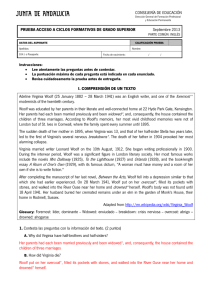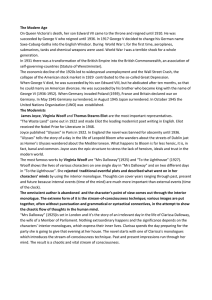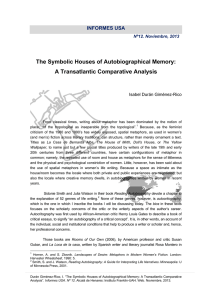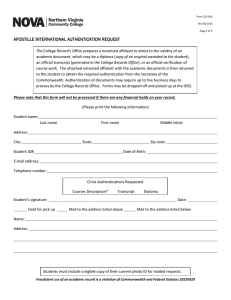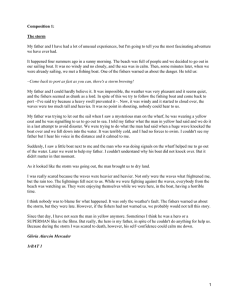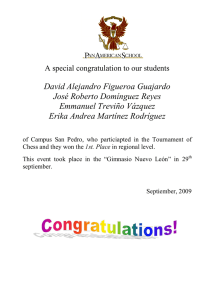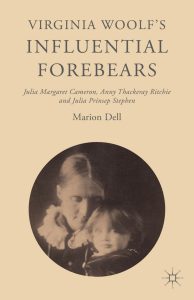jaclr - Universidad Complutense de Madrid
Anuncio
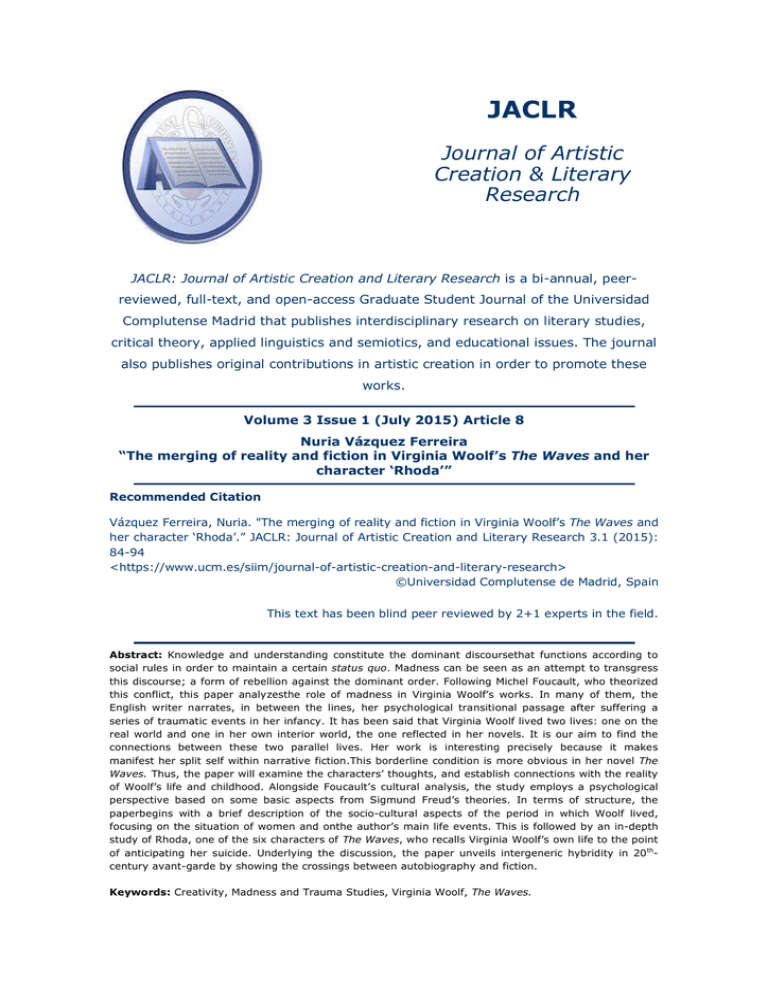
JACLR
Journal of Artistic
Creation & Literary
Research
JACLR: Journal of Artistic Creation and Literary Research is a bi-annual, peerreviewed, full-text, and open-access Graduate Student Journal of the Universidad
Complutense Madrid that publishes interdisciplinary research on literary studies,
critical theory, applied linguistics and semiotics, and educational issues. The journal
also publishes original contributions in artistic creation in order to promote these
works.
Volume 3 Issue 1 (July 2015) Article 8
Nuria Vázquez Ferreira
“The merging of reality and fiction in Virginia Woolf’s The Waves and her
character ‘Rhoda’”
Recommended Citation
Vázquez Ferreira, Nuria. "The merging of reality and fiction in Virginia Woolf’s The Waves and
her character ‘Rhoda’.” JACLR: Journal of Artistic Creation and Literary Research 3.1 (2015):
84-94
<https://www.ucm.es/siim/journal-of-artistic-creation-and-literary-research>
©Universidad Complutense de Madrid, Spain
This text has been blind peer reviewed by 2+1 experts in the field.
Abstract: Knowledge and understanding constitute the dominant discoursethat functions according to
social rules in order to maintain a certain status quo. Madness can be seen as an attempt to transgress
this discourse; a form of rebellion against the dominant order. Following Michel Foucault, who theorized
this conflict, this paper analyzesthe role of madness in Virginia Woolf’s works. In many of them, the
English writer narrates, in between the lines, her psychological transitional passage after suffering a
series of traumatic events in her infancy. It has been said that Virginia Woolf lived two lives: one on the
real world and one in her own interior world, the one reflected in her novels. It is our aim to find the
connections between these two parallel lives. Her work is interesting precisely because it makes
manifest her split self within narrative fiction.This borderline condition is more obvious in her novel The
Waves. Thus, the paper will examine the characters’ thoughts, and establish connections with the reality
of Woolf’s life and childhood. Alongside Foucault’s cultural analysis, the study employs a psychological
perspective based on some basic aspects from Sigmund Freud’s theories. In terms of structure, the
paperbegins with a brief description of the socio-cultural aspects of the period in which Woolf lived,
focusing on the situation of women and onthe author’s main life events. This is followed by an in-depth
study of Rhoda, one of the six characters of The Waves, who recalls Virginia Woolf’s own life to the point
of anticipating her suicide. Underlying the discussion, the paper unveils intergeneric hybridity in 20 thcentury avant-garde by showing the crossings between autobiography and fiction.
Keywords: Creativity, Madness and Trauma Studies, Virginia Woolf, The Waves.
85
Vázquez Ferreira, Nuria. "The merging of reality and fiction in Virginia Woolf’s The Waves and her
character ‘Rhoda’” JACLR: Journal of Artistic Creation and Literary Research 3.1 (2015): 84-94
<https://www.ucm.es/siim/journal-of-artistic-creation-and-literary-research>
©Universidad Complutense de Madrid, Spain
Nuria VÁZQUEZ FERREIRA
The merging of reality and fiction in Virginia Woolf’s The Waves and
her character ‘Rhoda’
1. Historical and Biographical Context
In spite of her psychological problems, Adeline Virginia Stephen, known after her marriage
as Virginia Woolf, grew up in privileged environment. In the absence of women’s public
higher education, she had the good fortune of having access to her father’s library, in their
home at 22 Hyde Park Gate Kensington, where the family received visits from some of the
most reputed intellectuals of her time.
Virginia’s parents had each been married previously and been widowed, and Virginia
had several stepbrothers and sister. It is said that she was a later speaker, but her ability
with words became evident quickly. She grew under the umbrella of her father’s power and
connections. Leslie Stephen was an important historian, critic, and founding editor of the
Dictionary of National Biography. Virginia grew up in a repressive patriarchal sphere which
becomes obvious in many of her works. The sudden death of her mother in 1895 when she
was 13, and of her half-sister Stella two years later, lead to one of the first nervous
breakdowns she was to suffer. In her diary, published later under the title A Sketch of the
Past, Virginia recounts and strange feeling of numbness and guilt in her inability to react to
her mother’s death. Even more traumatic, also narrated in her diary, was a certain episode
of sexual abuse by one of her step-brothers.
Between 1897 and 1901, seeking to distract his daughters, Leslie Stephen sent them
to the Ladies’ Department of Kings College London, where Virginia came into contact with
some of the higher education reformers of her day. However, it was not until 1919 under the
Sex Disqualification Removal Act that women were allowed to become professional lawyers,
vets, and civil servants. The passing of this law took place right after the global chaos of
World War I, when women were indeed needed to fulfil certain positions.
The death of Virginia’s father in 1904 provoked yet another mental breakdown and
she was institutionalised for a brief period. The family moved to the Bloomsbury
neighbourhood, a new urbanized area in central London, very close to the British Library.
Post World War I industrialization saw a 20% population rise in the major cities which rose to
30% by the end of World War II. Only two years after her father’s death, her brother Thoby
died of typhoid fever he had contracted while travelling abroad. The sisters are mentally
destroyed. Vanessa found support on her friendship with the critic Clive Bell, whom she
married in 1907. The group of intellectuals known as the Bloomsbury Group was born when
meetings started at the Bell’s household in 1910. Two years later Virginia marries Leonard
Woolf, a Jewish intellectual, with whom she was very happy until her suicide in 1941.
Woolf began to write professionally for the Times Literary Supplement in 1900, when
she was only 23. She wrote her first piece about Haworth, the home of the Brontë’s sisters.
In 1914 Great Britain entered World War I, this event delays one year the publication of her
first book The Voyage Out, her first novel which published in 1915 by her stepbrother's Gerald Duckworth, who was an editor and wanted to help Virginia recover from the
abuses his brother Gerald had inflicted on her and Vanessa when they were teenagers('A
Sketch of the Past', 69).
In 1917 the Woolf’s purchased the Hogarth Press, which allowed Virginia to publish
her experimental fiction. In November 11, 1918 the World War I ends. In 1919, the couple
purchase the Monk’s House, a cottage in the countryside; this same year Virginia publishes
Night and Day. In 1922 Virginia met Vita Sackville-West, a married woman and, under the
sexual freedom and open marriage agreement the Woolfs professed, they started a love
86
Vázquez Ferreira, Nuria. "The merging of reality and fiction in Virginia Woolf’s The Waves and her
character ‘Rhoda’” JACLR: Journal of Artistic Creation and Literary Research 3.1 (2015): 84-94
<https://www.ucm.es/siim/journal-of-artistic-creation-and-literary-research>
©Universidad Complutense de Madrid, Spain
affair with Leonard’s permission. This same year Virginia published a novel based on Thoby’s
death, called Jacob’s Room.In 1925 she published one of her most famous novels, a
modernist piece, which deals with a day in day in Clarissa Dalloway’s life, Mrs. Dalloway. In
1997, To the Lighthouse came out and her husband believed it to be the best of Virginia’s
novels. Just one year later Orlando, a book inspired on her affair with the writer Vita was
published. In 1929, she criticised the way patriarchal society restricted women’s movement
in a non-fiction format: her acclaimed volume A Room of One’s Own. 1931 saw the
publication of The Waves, and in 1937, she published The Years, to be followed by a
collection of feminist essays known as Three Guineas. Leonard published posthumously
Between the Acts, which was her final novel and A Writer’s Diary, a collection of personal
journals.
The beginning of World War II in 1939 and the fear of Nazi persecution due to
Leonard’s ethnicity caused the Woolfs huge anxiety, and they moved to the countryside. The
Hogarth Press was destroyed by the German’s bombs during The Blitz in 1940. Virginia
suffered yet another mental breakdown and filling her pockets with stones drown herself in
the Ouse River in 1941, leaving a goodbye note for her husband. Her body was discovered
three weeks later.
1931, Virginia Woolf publishes a masterpiece on the life of six friends, where there is
not necessary of a narrator, their inner voices and thoughts and the riding guide of the story,
considered by most of the critics as a play-poem. Even if nobody expects this yet, the novel
provides her anticipatory suicide through the character of Rhoda, just ten years before her
real suicide. In the following six years, George and Gerald, her half-brothers die; and in the
Spanish Civil War, her nephew, Julian Bell dies while driving an ambulance.
2. Virginia Woolf’s Artistic Legacy
Caught between the post Victorian/Edwardian lifestyle of her family upbringing, and the
emerging avant-garde trends of the 20th-century, Virginia Woolf’s works reveal a desire to
move beyond patriarchal structures into the modern world, a period which encompassed
great social shifts and transformations reflected on arts, literature, religion, politics and
economics. Make it New! was the motto coined by the North American poet Ezra Pound in
1934. Art was a mirror for this situation, and individualism, as well as concern with isolation
and death began to figure prominently in literature works. Somehow, artists and poets
thought that their role was to give hope to a society that had lost its values. This didacticaesthetic spirit is somehow also present in Virginia’s work, which was able to transmit the
energy, the feeling of the moment in which she wrote, an artist is a person who displays in
his/her work qualities required in art, such as sensibility and imagination, this ability made
Virginia into an artist.
Nowadays, Virginia Woolf is considered one of the most important writers of the early
20th-century, but during her lifetime her work was much less well known. Her style was
innovative and introduced new forms of expression which caused difficulties in reading.
Modernism was a window to redefine art’s form andopen the mind to new and fresh ideas.
Virginia Woolf’s use of‘stream of consciousness’as her most importanttechnique meant that
action and plot vanished, and the structure of the novel open up to a consciousness of
spatiotemporal mutability and change that came to define the characteristics of Modernism in
general.
Woolf’s first experimental novel Jacob’s Roomwas published the same year of James
Joyce’s Ulysses. One of the main characteristics of the Modernist writing style is the shift
from objectivity to subjectivity. Woolf’s main technique to achieve this goal was stream of
consciousness. Moreover, the use of silence, by means of silent images and thoughts
conveyed through actions, as well as free indirect discourse, were also used in an attempt to
capture the impressions that never get direct formulation as thoughts, as she stated in her
essay “Moments of Being.”Stream of consciousness,the most representative narrative
87
Vázquez Ferreira, Nuria. "The merging of reality and fiction in Virginia Woolf’s The Waves and her
character ‘Rhoda’” JACLR: Journal of Artistic Creation and Literary Research 3.1 (2015): 84-94
<https://www.ucm.es/siim/journal-of-artistic-creation-and-literary-research>
©Universidad Complutense de Madrid, Spain
technique in her work, refers to a mode of narration that follows the line of a character’s
thoughts as they occur. The term was first coined by Williams James in his book The
Principles of Psychology (1890), and the technique was fully developed by modernists
authors. Arthur Schnitzler (1862-1931) has been recognized as the first to use the technique
in his short story "Leutnant Gustl" (1900).
It has been argued that Virginia Woolf was afraid to fully live outside her fiction, and
that her narratives present a fluctuating cluster of distinct personalities which have
converted them in interesting cases for psychoanalytical and psychological study. The many
details of the traumas in her life and her constant psychological struggle since infancy, have
made Virginia Woolf one of the most enigmatic and mysterious writers of all times. The
theme of loss is obviously predominant in all her narrative fictions. Alongside the loss for the
death of her mother, her stepsister, her father and her brother in less than 10 years emerge
her feelings of guilt and trauma over the loss of certain aspects of her own innocence at the
hand of her stepbrother.
As many other remarkable authors, such as Sylvia Plath, Virginia Woolf explored her
inner mind and her worries through literature, she wrote as a means of psychological
release, as a therapeutic experience. Even without being conscious of that, Virginia was able
to psychoanalyze herself through writing, that is, through her imagination. Woolf’s works
follow a common line through the human mind processes: thoughts, consciousness, visions,
wishes, smells, every detail that happens constantly in life and that normally we don’t even
pay attention to them; she was able to capture the energy of every moment and transmit it
in a smart and multidimensional way. Her stories capture the changing life of human mind.
Through her novels we can observe an autobiographical line, assigning this way to her
characters the feelings and thoughts she felt not able to express in her real life.
Thus, Virginia puts into words her painful experiences which produced all the
traumas she carries, by this way, she is using the process of writing her novels as a way of
taking away the pain; the process of writing is the moment she release her sorrows. A
traumatic event, according to Cathy Caruthis “an event that is not assimilated or experienced
fully at the time, but only belatedly, in its repeated possession of the one who experiences it.
This event is only recalled in form of hallucinations, nightmares.” (2014, 35) The idea of
death is one of the hardest concepts to assimilate, it implies assimilating that someone ‘is
not’ anymore, it is abstract, so there is not a physical concept to explain it, just the simple
idea of ‘not to be’. One thing that puts pain away is time, and the other is talking about it,
making it touchable through words, but Virginia’s father always forbid talking about death,
which generated internal tensions at her home. According to Robert E. Seaman, “it is
necessary to view her breakdowns as a desperate response to a desperate fear.” (1992,
87)Thus, this paper focuses on the traumas that may be hidden under the character of
Rhoda in The Waves. While using a psychological perspective, the paper also picks up on
Michel Foucault’s concept of power structures, as mentioned above.
In March 1941, Woolf gave up on a life that had always been a challenge for her. Her
thoughts expressed in words, of this crucial moment have remained. It seems that writing
was sole mode of living. Her suicide letter, addressed to her husband Leonard, confessed
that she was not able to fight any longer. She dealt with the issue of death throughout her
life, always struggling against her fear of dying, something that somehow her gave life
sense. Her traumas were her curse but also, in a way, her cure. Her universe was stored up
in her imagination, unable to come to her conscious side. Her writings are made up of a flux
of hidden memories, somewhat silenced in their harshness, never fully expressed except in a
fictional way through the characters of her novels.Ten years prior to her suicide she had
written a novel that can be considered premonitory: The Waves.
3. The Waves (1931)
Many critics observe that Woolf’s art as a way of representing unconscious material, one of
the most magnificent aspects of her writing style. A capacity of transmitting the inner
88
Vázquez Ferreira, Nuria. "The merging of reality and fiction in Virginia Woolf’s The Waves and her
character ‘Rhoda’” JACLR: Journal of Artistic Creation and Literary Research 3.1 (2015): 84-94
<https://www.ucm.es/siim/journal-of-artistic-creation-and-literary-research>
©Universidad Complutense de Madrid, Spain
feelings and emotions through thoughts that comes to life inThe Waves, possibly her most
experimental novel. A work that broke her readers’ expectations causing a huge impact in
the critical reception of her time.
The description of the characters in the novel is presentedby means of stream of
consciousness technique. The reader feels as if being inside the characters’ minds, observing
their thoughts, objectives in life, feelings, and so on.The content of Woolf’s The Waves might
be rather conventional, a story of a group of friends and their lives from childhood into
adulthood, their fears, their dreams and aspirations their love affairs, their achievements,
their deaths. In a New York Times review, Louis Kronenbergerargued that “Mrs. Woolf has
not only passed up superficial reality; she has also passed up psychological reality.” (1931,
1) In my view, Woolfdevises thenarrative as a poetic piece, rather than a novel, and treats
the characters’ feelings as if they were collective. Rich in sensibility, the metaphor of the
waves is important and signifies Woolf’s capacity to arrest all the energy of one moment
suspended in time, and them releasing it suddenly with great force only to see the energy
vanish.
Charles Olson’s essay Projected Verse (1950), published almost 20 years after The
Waves, presents similar ideas. It focuses on the kinetic aspects of life, with the writer
capturing the energy of a moment and transmitting this energy. The form is, thus, not just
an extension of the content, but something with power itself. The process of writing is itself a
recreation of this élan vital (vital force), as introduced by the French philosopher, Henry
Bergson in his 1907 book, Creative Evolution, which Bergson linked closely with the intuitive
perception of experience and the flow of inner (subjective) time, a conception that
significantly influenced modernist writers including Marcel Proust and Virginia Woolf herself.
In this ‘vital impetus’ one perception and desire leads to the following in a sort of
evolutionary continuity.
The structure of the novel is also framed by the image of the waves crashing on the
shore. Six characters, first children, then adults, are described.As the novel advances, the
rhythm of the waves becomes associated with the passage of time. This idea of continuity
shapes the entire novel, which ends as it begins, with the image of the breaking waves.
Imagery of water is omnipresent in Woolf’s novels. She associated water with the
flow of life, with a sort of calmness related to the most basic feelings, with the movement of
human destiny, and even with death, which is a punctual occurrence in human life, while
nature’s time is eternal. While water flowing and the rhythms of the waves might have a
soothing effect, in “Moments of Being”, Woolf describes several episodes where she is unable
to cross a puddle of water, which seems to be unconsciously associated to some of her
childhood traumas. In The Waves, she associates the rhythm of waves with each cycles of
life, from childhood to maturity.
From my point of view, the main topic is the fugacity of life, and the way people live
without fully living, that is, without become aware of the transitory passing through life. The
novel also portrays the value of real friendship and companionship, even during moments
when people are set apart and far away from each other. Woolf’s novels tend to present a lot
of characters while she focuses on one or two more closely. Despite the emphasis on
companionship, the general feeling is that of incommunication; as if characters lived only in
their dreams and aspirations without fully realizing what life is. Of course, this might just be
the result of reading into their minds through the stream of consciousness technique.
The Waves has a structure that uses movable centres around several characters.
First, Percival,one of the six characters, the first to die at war, and to remain in the minds of
all others.Percival’s image lives in his friends’ minds to remind them of the passing of time,
as the following quote from Rhoda’s reflections indicates:“everybody is doing things for this
moment only; and never again’, ‘this shall endure’.”(The Waves 16)The presence of death
and the idea of tempus fugit and carpe diem are made tangible throughout the novel.
89
Vázquez Ferreira, Nuria. "The merging of reality and fiction in Virginia Woolf’s The Waves and her
character ‘Rhoda’” JACLR: Journal of Artistic Creation and Literary Research 3.1 (2015): 84-94
<https://www.ucm.es/siim/journal-of-artistic-creation-and-literary-research>
©Universidad Complutense de Madrid, Spain
The six characters are very different from each other. Three women and three men,
each of them with different aspirations and views towards life. They have in common the fact
that all of them follow their instincts and passions, their élan vital, in as much as they are
allowed by their society. Despite the emphasis on friendship, the characters feel isolated,
and one much more than the others. Rhosa frequently describes herself as having not the
same identity as the rest; as having no identity, no face. The face is the part of our organism
that makes us recognisable to the others. It is easier to perceive physical differences on the
face than on any other part of the body. This feeling of isolation, present throughout her
novel, can also be contemplatedas an anticipation of her suicide.
Virginia Woolf is Rhoda. She could be described as mad, or just as being depressed
with the life she leads. The world around her does not fit her expectations, leading her to
reject it. Woolf transmits through Rhoda her own vision of life, and there are many evidences
of the connection between author and character.Moreover, Rhoda’s madness is not just a
mental illness but a way to challenge power positions in the world around her. In this sense,
and as Foucault argued, madness is a form of transgression.
From the first dialogue, Rhoda seems to perceive the world in a very different way
from her friends’ perspectives. In the first scene of childhood, while they describe what they
see, Rhoda describes what she hears. Like Woolf herself, Rhoda struggles with her incapacity
to assimilate tragic events in her life, to move beyond. But she senses herself different to all
others, with her own distinct sensibility, and an extreme eagerness for solitude, even as a
child. She does not follow the others; her time lags behind societal time. She is hidden down
under, while the others are achieving success: “Up here Bernard, Neville, Jinny and Susan
(but not Rhoda) skim the flowerbeds with their nets.”(The Waves 6)
This feeling of solitude is shown in the following quotes, where Rhoda expresses her
emotion of being alone as a release from the real world, a way of escaping from some kind
of oppression: “I have a short time alone, while Miss Hudson spreads our copybooks on the
schoolroom table. I have a short space of freedom.” (The Waves 9) A few lines later she
expresses her feelings of abstraction, in a sort of ideal world: “But I cannot write. I see only
figures.” (The Waves 10). And always her feeling of being outside the world, and her feeling
of sadness for not being like the others: “The world is entire, and I am outside of it, crying.”
(The Waves 11)
As mentioned above, Michel Foucault theorized the concept of power as the way in
which the rules of society are established. The mechanisms of power in society are set up by
certain ruling institutions and people. For Foucault, those who place themselves outside the
society rules are mad. Madness is thus a form of power transgression, but also a disease
with an impossible cure as Rhoda acknowledges: “I am alone in a hostile world. The human
face is hideous. This is liking. I want publicity and violence and to be dashed like a stone on
the rocks. (..) I am sick of privacy. I ride rough waters and shall sink with no one to save
me.” (The Waves 70).
The term ‘hostile’ in the paragraph above can be interpreted as a criticism to a
society ruled by structures of power outside Rhoda’s control. A patriarchal and oppressive
society, monopolized by men, where a woman was never seen and valued.
The context is also important for after World War I (1914-1918)mental illnesses and
depressions reached very high rates in many countries. Suicide patterns were common
among the ex-soldiers, as Woolf’s herself illustrates through the character of
Septimus Warren Smith in Mrs Dalloway.Rhoda expresses a fear of losing people, and this
feeling is perhaps one of the reasons that prevents her from getting to close to others: the
fear of losing them late: “I attach myself only to names and faces; and hoard them like
amulets against disaster”(The Waves 23)
In the same paragraph she expresses her feeling of being outside of her body, as if
her physical self were not a unique entity; as if she was some sort of porous surface that can
be penetrated by others. Her isolation is a form of self-protection; an expression of her
90
Vázquez Ferreira, Nuria. "The merging of reality and fiction in Virginia Woolf’s The Waves and her
character ‘Rhoda’” JACLR: Journal of Artistic Creation and Literary Research 3.1 (2015): 84-94
<https://www.ucm.es/siim/journal-of-artistic-creation-and-literary-research>
©Universidad Complutense de Madrid, Spain
unwillingness to merge with the world around her and lose that identity that she does not
even feel she has: “Alone, I rock my basins; I am mistress of my fleet of ships. But here,
twisting the tassels of this brocaded curtain in my hostess’s window, I am broken into
separate pieces; I am no longer one. (...) But I doubt, I tremble; I see the wild thorn tree
shake its shadow in the desert.” (The Waves 50) All this lines present Rhoda, and Woolf, as
over sensitive characters; able to catch the emotions around them as if they were rays of
light penetrating their body. Empathy is Rhoda’s weakness. The same empathy that causes
her fears andfeelings of powerlessness.
Rhoda is mad. Madness is the result of her feelings of abnormality; of being unable
to feel control over herself and others. In a way, product of a social order, madness is the
attribute of those who feel marginalized, or perhaps discriminated; of those who feel outside
social structures. In Madness and Civilization: A History of Insanity in the Age of Reason
(1988), Foucault traces the evolution of the concept of madness through these three phases:
the Classical Age, the Renaissance, and the Modern age. Emotional oversensitivity puts
people on the verge of madness. Their emotional states vibrate in tune with those of all
others around them. They can go up unvanquished in one moment, and fall down
surrendered the next, just like a wave. Nowadays diagnosed as bipolar disorder, Woolf and
Rhoda’s ups and downs are the result of her capacity to empathize, to absorb the emotions
of others, particularly their pain, to the point of unreason:
Rhoda comes now, from nowhere, having slipped while we were not looking. She
must have made a tortuous course, taking cover now behind a waiter, now behind
some ornamental pillar, so as to put off as long as possible the shock of recognition,
so as to be secure for one more moment to rock her petals in her basin. We wake
her. We torture her. (The Waves 67)
Rhoda’s character is illuminatedin the light of Foucault’s ideas, as the mad one, who
behaves in a differentlyand is consequently marginalised
Oh, life, how I have dreaded you,’ said Rhoda, ‘oh, human beings, how I have hated
you! How you have nudged, how you have interrupted, how hideous you have looked
in Oxford Street, how squalid sitting opposite each other starting in the Tube! Now as
I climb this mountain, from the top of which I shall see Africa, my mind is printed
with brown-paper parcels and your faces. I have been stained by you and corrupted
(The Waves 115)
In terms of humanity, the reaction against madness has always had a tendency to
discrimination. Society is afraid of those who show signs of weakness, or of oversensitivity,
for they create a sense of embarrassment, and sometimes act against propriety. Society
keeps mad people as far away as possible; locked up in an asylum; relegated to the attic of
the house. The mad woman is a particularly dangerous subject. She speaks her mind and in
her speech, she challenges social rules. So tears the yellow-wallpaper coverings of the prison
cell of the conscious mind. She seems afraid, but has much less fear than all others. The
conception of madness, Foucault shows, changes with the mechanisms of social control. For
religion, mad people are possessed by devils. For politicians, madness is a threat difficult to
control.The so-called ‘mental homes’, argued Foucault are invisible forms of discipline that
oppress individuals encouraging them to censor aspects of themselves and of their actions,
and influence their views and ways of living, slowly gaining control over them. It may be
difficult for us to understand this today. The defence of human rights has advanced a lot, at
least in most Western societies. But we must remember, for instance, that when the
novelOne Flew Over the Cuckoo's Nest was published in 1962, the civil rights movement was
only starting in the United states.
91
Vázquez Ferreira, Nuria. "The merging of reality and fiction in Virginia Woolf’s The Waves and her
character ‘Rhoda’” JACLR: Journal of Artistic Creation and Literary Research 3.1 (2015): 84-94
<https://www.ucm.es/siim/journal-of-artistic-creation-and-literary-research>
©Universidad Complutense de Madrid, Spain
Discrimination against women appears in The Wavesin different forms, For instance,
there is a clear opposition between younger and older women. In Woolf’s society, adult
middle and upper-class womenwere supposed to have children and stay at home, while men
were able go to college. However, this historical situation was about to change asthe fight for
women rights had started and became stronger after World War I. Woolf herself, even in the
background of intellectualism that surrounded her, had to have German, Greek and
Latinlessons fist at home, and then at a special section at the Ladies’ Department of King’s
College in London.
The term ‘hysteria’ describes unmanageable emotional excess, came from the Greek
word ‘hystera’ or uterus, creating an immediate association with a feminine condition, that
became particularly popular after Sigmund Freud investigations in the late 19th and early
20th-centuries where he put forth an innovative clinical use of hypnosis to demonstrate that
hysteria could be related to repressed sexual traumas taking place in infancy. In Trauma and
Recovery: The Aftermath of Violence: From Domestic Abuse to Political Terror, Judith
Herman has suggested that Freud’s findings were related to a routine of domestic abuse
suffered by women, and which included emotional and physical abuse, including sexual
advances, as in the case of Virginia Woolf (1992, 10-16). Given the contemporary rate of
domestic violence, this does not seem difficult to believe.
One of Freud’s most important theories was put forth in the The Ego and the Id
(1923). It refers to the split of the human psyche in three aspects, theid, the ego and the
superego. The id, this is the primitive and instinctive component of personality; it demands
immediate satisfaction, and it is illogical and irrational; for instance, a new-born child is all
id. The ego represents that part of the id that has been modified by the outside world, it is
the decision making component of personality, and it is always changing with new
experiences. Freud made an analogy which clearly explains the connection id-ego: the ‘id’
was like a horse and the ‘ego’ the rider. Finally, the superego incorporates the values and
morals of society, which are learned from one’s parents and others influences of the external
world.The traumas suffered in infancy affect the formation of the id and the ego. Although
these traumas are silenced and hidden in the ‘back’ of the mind, they re-emerge at times of
stress, when manic (the ego dominating the superego) or narcissistic (the id dominating)
phases may emerge. The conflict is negated and the object that produces the psychological
pain is immediately blocked, as a mechanism of protection.
Virginia Woolf’s diaries are a testimony that the author underwent these phases at
different times and during several periods of her life. According to researchers, two of the
human relationships which generate more stress on people are the loss of a relative,
particularly the parents or protecting figures, and sudden changes in one’s life such as
marriage. Freud became a popular read during Woolf’s lifetime, and his works were
translated from German into English by a member of the Bloomsbury group and a friend of
her husband and herself, James Strachey. The Woolf’s own publishing house, Hogarth Press,
published the so-called Standard Edition of Freud’s work. Woolf was aware that the talking
cure, and in the case the writing cure, might be beneficial for her. Some of her novels are
indeed examples of therapy directed upon herself, just as her diaries. The resort to writing
came natural to Woolf, who had started to put down things as early as eight years old when
she penned articles for ‘Hyde Park Gate News’, a local newspaper.
Many critics have studied Woolf’s use of language, her complicated and elaborated
vocabulary, full of digressions, that has been said to reflect female language but also the
language of hystera, the womb, a language of madness. Woolf’s fiction unveils some of her
hidden problems and worries. It is through her characters that she is able to givevoice to
those feelings and emotions she otherwise feels unable to express. The turn to imaginative
states of the mind has also been found by specialists to satisfy the basic instincts of the id,
avoiding external reality by escaping into a parallel world of fantasy.
92
Vázquez Ferreira, Nuria. "The merging of reality and fiction in Virginia Woolf’s The Waves and her
character ‘Rhoda’” JACLR: Journal of Artistic Creation and Literary Research 3.1 (2015): 84-94
<https://www.ucm.es/siim/journal-of-artistic-creation-and-literary-research>
©Universidad Complutense de Madrid, Spain
Woolf’s character Rhoda is portrayed as a lonely woman, alienated from the society
around her; detached from social order. By all accounts, Rhoda seems to be a reflection of
the author’s psyche, as well as a vehicle to criticize society, when she affirms: “This is part of
the emerging monster to whom we are attached.”(The Waves 34) Like Woolf, Rhoda persists
in inhabiting in her own imaginary world rather than the real one: “’now I spread my body on
this frail mattress and hang suspended. I am above the earth now. I am no longer upright,
to be knocked again and damaged.”(The Waves 14)
Patients suffering from hysteria and bipolarity disorders are also often diagnosed with
a number of symptoms known as ‘Cassandra Complex’. The terms originates in the figure of
Cassandra, the daughter of Priam, King of Troy whom Apollo tried to seduce by conferring
upon her the gift of prophecy. When Cassandra rejected him, Apollo placed a curse on her so
that nobody would believe her warnings. Thus, Cassandra can read the future but cannot
convince others of the truth of her predictions. In patients with this psychological condition,
isolation and manifestations of social dysfunction accompany an ambiguous emotional state,
where the sufferer seeks solitude but at the same time regrets being disbelieved and
dismissed from the social group.Overall, what the syndrome hides is a tendency to hide and
deny reality as a defence against the anxiety of guilt related to the traumatic event in the
past.
Like Woolf, Rhoda, shows this fractured identity continuously in the story: “but here I
am nobody. I have no face. This great company, all dressed in brown serge, has robbed me
of my identity.” (The Waves 18)Rhoda’s contradictory personality emerges again and again:
But I did not hide behind them. I walked straight up to you instead of circling round
to avoid the shock of sensation as I used. But it is only that I have taught my body
to do a certain trick. Inwardly I am not taught; I fear, I hate, I love, I envy and
despise you, but I never join you happily’ (The Waves 126)
The same ambiguity appears when she judges the behaviour of others: “Making love
to a nursemaid behind a tree, that soldier is more admirable than all the stars. Yet
sometimes only trembling star come in the clear sky and makes me think the world beautiful
and we maggots deforming even the trees with our lust.” (The Waves 128). In this sentence,
the anarchy of nature is compared to the brutality of war, and even of sex. The figure of the
tree, a constant element in Woolf’s fiction, emblem of life, is seen here as a symbol of death,
eaten by maggots.
It is important to point out that this double nature of Rhoda, and of Woolf herself,
become visible when dealing with male figures that symbolise power structures, such as the
soldier above. In particular, Rhoda’s psyche seems to rejects the rules imposed by the superego, those described by Foucault as manipulative and oppressive towards individuals. The
conflict with her father is possiblethe most important issue critics have pointed out when
dealing with the social aspects of Woolf’s personality. Just like Woolf, Rhoda does not feel
identified with her paternal figure, an oppressive patriarch who subjugated the women in his
household. Woolf’s diaries record some of the most important differences between her
personality and that of her father and his non-imaginative, conventional mind. The death of
her mother may have caused Woolf to look for a mother figure replacement, looking for her
father’s approval in a home dominated by males.
There was something we had in common. ‘What have you got hold of?’ he would say,
looking over my shoulder at the book I was reading; and how proud, priggishly, I
was, if he gave his little amused surprised snort, when he found me reading some
book that not child of my age could understand. I was a snob no doubt, and read
partly to make him think me a very clever little brat. And I remember his pleasure,
93
Vázquez Ferreira, Nuria. "The merging of reality and fiction in Virginia Woolf’s The Waves and her
character ‘Rhoda’” JACLR: Journal of Artistic Creation and Literary Research 3.1 (2015): 84-94
<https://www.ucm.es/siim/journal-of-artistic-creation-and-literary-research>
©Universidad Complutense de Madrid, Spain
how he stopped writing and got up and was very gentle and pleased when I came
into the study. (Letters I, 221)
Woolf aims at women having the same chances as men. She wishes them to be
measured at the same scale. But this is only wishful thinking. In her novels, in her bisexual
attitudes, in her vision of androgyny reflected in works like Orlando, Woolf, negates women.
An eagerness to please her father is hidden behind her defence of women issues. The
negation of herself as woman is embodied in all her characters and it takes extreme forms,
as in Rhoda, where the sense of non-identity is an early symptom of her death as a social
self.
As I have argued, Woolf’s inability to face real life produces the sensation of nonbeing in her novels. Having no-identity is directly linked the absence of life. In her diaries,
Woolf often describes episodes similar to those portrayed by Rhoda, where she feels her
body and her mind as different entities; a sort of mystical awareness where she
contemplates herself as one and as other, not belonging to the same person. This situation
of fear and guilt for being unable to fit in social life, causes Rhoda (and Woolf) great stress.
They often regress into a narcissistic modes of protection, hidden in their id, allowing the
growth of their world of fantasies and imagination: “Because you have an end in view,-one
person, is it, to sit beside, an idea is it, your beauty is it?’ ‘but there is no single scent, no
single body for me to follow. And I have no face’ (The Waves 72)
Woolf’s life, like Rhoda’s, was shadowed by death. Her father forbid talking about it
at home, after her mother’s death, was a way to avoid the pain and the guilt of his treatment
towards her. Woolf’s own homage to her mother in To the Lighthouse, or in Mrs. Dalloway,
takes the form of a defence of female identity and supports women’s role within the family:
“If we could remain untouched without any support—but you, disturbed by faint clapping
sounds of praise and laughter, and I, resenting compromise and right and wrong on human
lips, trust only in solitude and the violence of death, and thus are divided.” (The Waves 130)
4. Conclusions
On January 25th, 1882, Virginia Woolf began her troublesome lifein an environment where
death played an important role. Both of her parents had experienced the death of their
partners. She herself suffered the shock of her mother’s death, from which she never
recovered. The passing of her brother Thoby, at only 26, dealt yet another blow. Woolf learnt
to escape into a fantasy world in which her novel became the scenery of the problems with
which she was unable to deal in real life.
The Waves (1931) was published ten years before Woolf died at 49. This paper has
explored the character of Rhoda, read as an anticipation of the suicide of the author, along
the lines of previous psychoanalytical readings. However, this paper has also argued for a
second reading of The Waves, sociological as well as a psychological. If in the first reading,
Rhoda prefigures Woolf’s psychological struggle with madness, in the second, madness
becomes radicalway of thinking gender difference, one that stresses that “We cannot sink
down, we cannot forget our faces. Even I who have no face, who make no difference when I
come in (Susan and Jinny changed bodies and faces), flutter unattached, without anchorage
anywhere.” (The Waves 68)
Works Cited
García Nieto, Rebeca. "Virginia Woolf : Clinical Case."Revista de la Asociación Española de
Neuropsicología. 2004: 69-87. Web.
Ferro, Lorena. ‘El suicidio de Virginia Woolf’. La Vanguardia. Hemeroteca 28 marzo 2011
94
Vázquez Ferreira, Nuria. "The merging of reality and fiction in Virginia Woolf’s The Waves and her
character ‘Rhoda’” JACLR: Journal of Artistic Creation and Literary Research 3.1 (2015): 84-94
<https://www.ucm.es/siim/journal-of-artistic-creation-and-literary-research>
©Universidad Complutense de Madrid, Spain
<http://www.lavanguardia.com/hemeroteca/20110328/54131789612/el-suicidio-devirginia-woolf.html> Last Accessed 3-6-2015
Foucault, Michel. Madness and Civilization: A History of Insanity in the Age of Reason. New
York: Vintage Books, 1988. Print.
Glogowski, James, Panken, Shirley, Seaman, Robert E., and Caramagno, Thomas. “Virginia
Woolf and Psychoanalytic Criticism.” PMLA. 103.5. (1988): 808-812 Web.
<http://www.jstor.org/stable/462519>Last Accessed 3-6-2015
McLeod,
Saul.
(2008).
‘’Id,
Ego
and
Superego.’’
Retrieved
from
<http://www.simplypsychology.org/psyche.html>Last Accessed 3-6-2015
Herman, Judith. Trauma and Recovery: The Aftermath of Violence: From Domestic Abuse to
Political Terror. Basic Books. 1992
Montashery, Iraj. Rhoda’s Non-Identity in Virginia Woolf’s The Waves. PhD Dissertation.
Iran: Islamic Azad University: Advances in Asian Social Science (AASS) 4. 2 (2013): 806809<http://worldsciencepublisher.org/journals/index.php/AASS/article/viewFile/1209/931
>Last Accessed 3-6-2015
Nicolson,Nigel and Trautmann, Joanne (Eds)The Letters of Virginia Woolf. London: Mariner
Books, 1982
Palomo Berjaga, Vanessa. “El monólogo interior en dos fragmentos modernistas: The Waves
y Ulysses.” Revista Forma 2 (2012): 95-104. Universitat Pompeu Fabra
<http://www.upf.edu/forma/_pdf/vol02/forma_vol02_10palomovanessa.pdf>Last
Accessed 3-6-2015
Sackville, Amy. “Book of A Lifetime: The Waves, by Virginia Woolf.” The Independent 16
April 2010. <http://www.independent.co.uk/arts-entertainment/books/reviews/book-ofa-lifetime-the-waves-by-virginia-woolf-1945744.html>Last Accessed 3-6-2015
Woolf, Virginia. The Waves. London: Wordsworth Classics, 2000. Print.
Bioprofile of the author: Nuria Vázquez Ferreira holds a Degree in English Studies from
the Complutense University of Madrid. Her area of interest is psychoanaltical studies and
comparative literature, dealing with mind and society connections. She also did an internship
at the Westfälische Wilhelms-Universitat of Münster as teacher of Spanish language.
Contact: <[email protected]>
